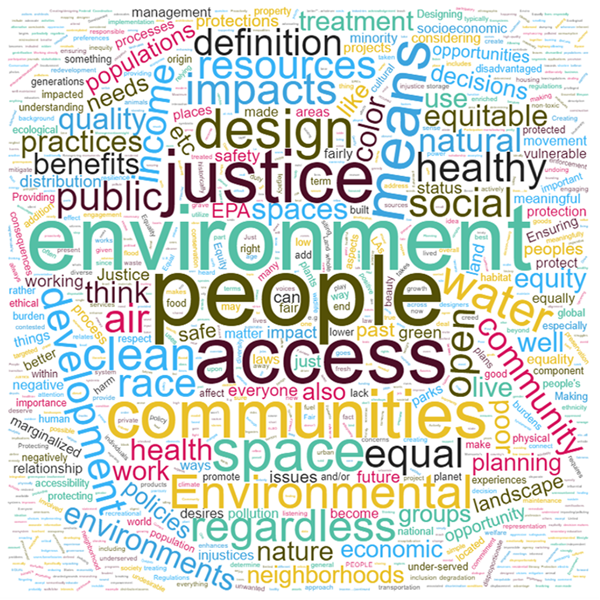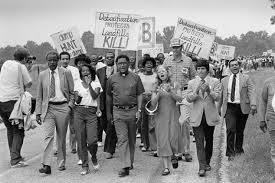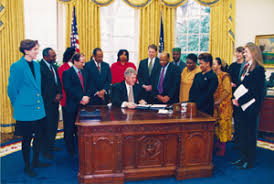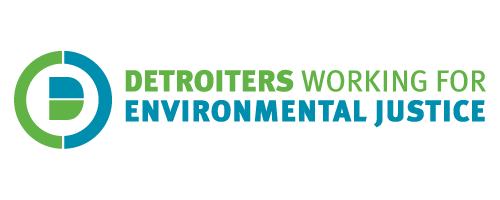ENVIRONMENTAL JUSTICE MATTERS
What is Environmental Justice?

Image courtesy of Dr. Chingwen Cheng Originally published in the American Society of Landscape Architects (ASLA) 2019 Environmental Justice Professional Practice Network Survey
Environmental justice is based on the reality that certain groups in society bear unequal environmental and economic burdens like poor air and water quality, as well as unhealthy living conditions resulting from industrial, municipal, and commercial operations and/or federal, state, and local laws, regulations, and policies. It is the idea that all people and communities have the right to equal environmental protection under the law, and to the right to live, work and play in communities that are safe, healthy and free of life-threatening conditions. Environmental justice is made possible when all communities have access to information and decision-makers that enable them to take action and create positive change for themselves.
While there is no single legal definition for environmental justice and the concept continues to evolve, there are shared themes of equal protection, community involvement and healthy living environments. According to the US Environmental Protection Agency (EPA), environmental justice is “the fair treatment and meaningful involvement of all people regardless of race, color, national origin, or income, with respect to the development, implementation, and enforcement of environmental laws, regulations, and policies.” Our home state of Michigan defines environmental justice in much the same way.
Find more videos about Environmental Justice on our YouTube Channel
Guiding Principles
In addition to the goals that environmental justice groups seek to achieve, they also tend to lay out and agree on foundational principles that guide their actions to become just, equitable and inclusive. Two such sets of principles—or best practices— were crafted in the 1990’s and have been widely adopted by social and environmental justice groups, including Detroiters Working for Environmental Justice. They guide us as we create genuine community partnerships with integrity. These partnerships help bridge cultural, political and organizational differences.
- The Principles of Environmental Justice
The First National People of Color Environmental Leadership Summit was held from October 24 – 27, 1991 in Washington, D.C. There, delegates (including founding members of Detroiters Working for Environmental Justice) drafted and adopted 17 principles of Environmental Justice. Since then, the Principles have served as a defining document for the growing environmental justice movement. Read the Principles of Environmental Justice
- The Jemez Principles of Democratic Organizing
Forty members of the environmental justice movement met at the Working Group Meeting on Globalization and Trade held in Jemez, NM between December 6 – 8, 1996. These representatives generated a set of guidelines to create common understanding among people from divergent cultures, political backgrounds, and organizations. Read the Jemez Principles of Democratic Organizing




A Short History of Environmental Justice
Environmental justice can trace its roots back to civil rights and social justice events in the 1960’s, such as when Latino farm workers in California organized and fought for workplace rights and health safety, or when African-American students in Houston protested a city garbage dump in their community, or when residents of Harlem, NYC joined together to fight a sewage treatment plant in their neighborhood.
Those events laid the foundations for the 1982 protests in Warren County, NC, which many people point to as the event that truly launched the environmental justice movement. There, local residents of color organized protests over a state decision to move contaminated soil from roadsides across the state to a landfill in Warren County, one of only a few counties in North Carolina with a majority Black population.
Find more videos about Environmental Justice on our YouTube Channel
While they were ultimately unsuccessful in their efforts, the Warren County protests and organizers helped spark a far larger movement that started gaining national attention. The movement was aided greatly by data from landmark reports by the US Government Accountability Office in 1983 and the United Church of Christ in 1987. Each study found that hazardous and toxic waste sites were more likely to be located near Black and Latino communities and that race, more so than socioeconomic status, was the most important predictor of where the toxic sites were located.
In the 1990’s, the environmental justice movement continued to grow across the country by building alliances with other environmental and social justice organizations. In 1994, the movement was formally recognized at the federal level when President Clinton signed Executive Order 12898, which established environmental justice offices in the EPA, Department of Justice and other federal agencies.
Today environmental justice continues to grow, evolve and become integrated into official public policy. The groups which emerged from this movement on all levels of society (grassroots, regional, international), give countless people a voice in their fight against environmental, health and social injustices.
